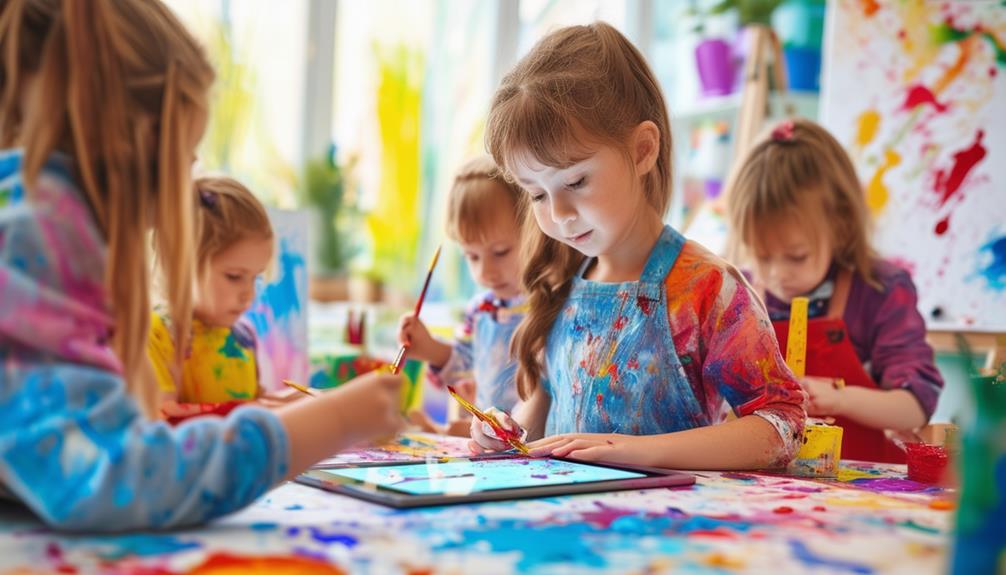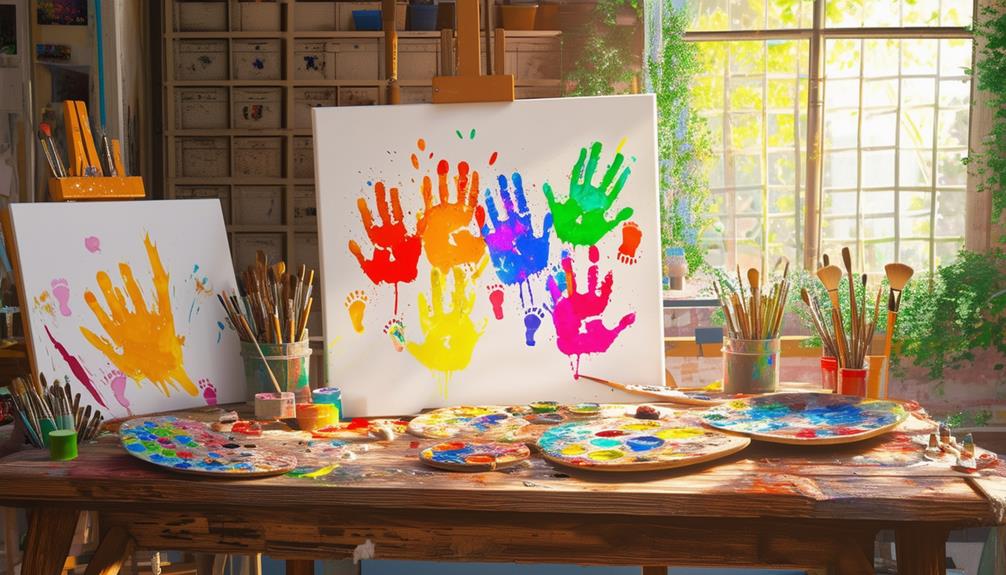Painting With Natural Materials: Leaves, Rocks, and More
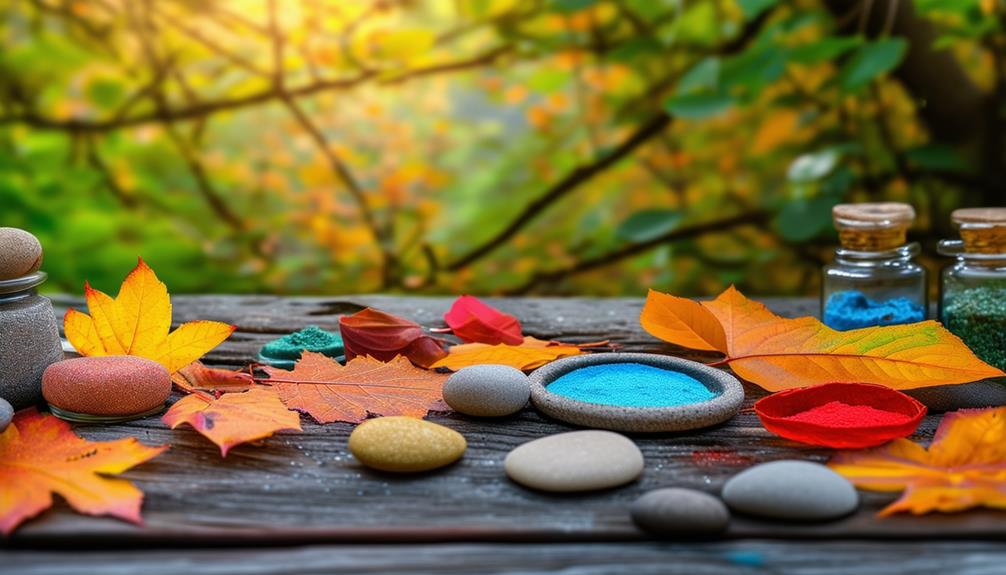
Imagine transforming ordinary leaves, rocks, and other natural finds into stunning pieces of art. Nature provides an abundance of colors and textures, eliminating the need for traditional paints. By exploring techniques such as leaf stamping, rock painting, and flower crafting, you can create unique artwork. Have you considered making your own natural paints from clay, berries, or grass? These methods not only add an element of surprise to your art but also foster a deeper connection with the environment. Ready to embark on this eco-friendly artistic journey?
Foraging for Supplies
When you're ready to start your project, grab a paper bag and head outdoors to gather natural supplies like sticks, pebbles, and leaves. Using paper bags helps keep your collected items safe and organized for easier sorting later. By collecting natural materials, you not only gather unique items for your art projects but also cultivate responsibility and respect for nature.
Encourage children to pick up leaves, sticks, pebbles, and pinecones, as these diverse materials can fuel creativity in countless ways. Remind them to take only what they need and to be gentle with the environment, ensuring they leave no trace behind. This practice fosters a sense of stewardship and appreciation for the natural world.
The process of gathering supplies can be a fun and educational adventure. Look for a variety of textures, shapes, and colors in the natural materials you collect. This variety will add depth and interest to your art projects. It's also a fantastic way to explore the outdoors and observe the changing seasons. So, start your collection, knowing you're fostering a deeper connection with nature.
Preparing Natural Paints
After gathering your natural supplies, it's time to transform them into beautiful, eco-friendly paints. Start by using clay-based rocks. Crush these rocks into a fine powder, then mix the powder with a small amount of water. Less water will result in more vibrant paint.
Berries are another excellent source for natural paint. Blend the berries with minimal water until you achieve a smooth consistency, which will yield a range of vivid colors suitable for various art projects. Grass and leaves can also be blended with water to create unique shades of green. Again, using less water will keep the colors more intense.
Feel free to experiment by mixing different materials. Combining rock powders with berry or leaf mixtures can produce an impressive variety of colors. Each blend offers its own unique hue, encouraging creativity. The beauty of natural paint lies in its unpredictability and the endless possibilities it offers.
Leaf Painting Techniques
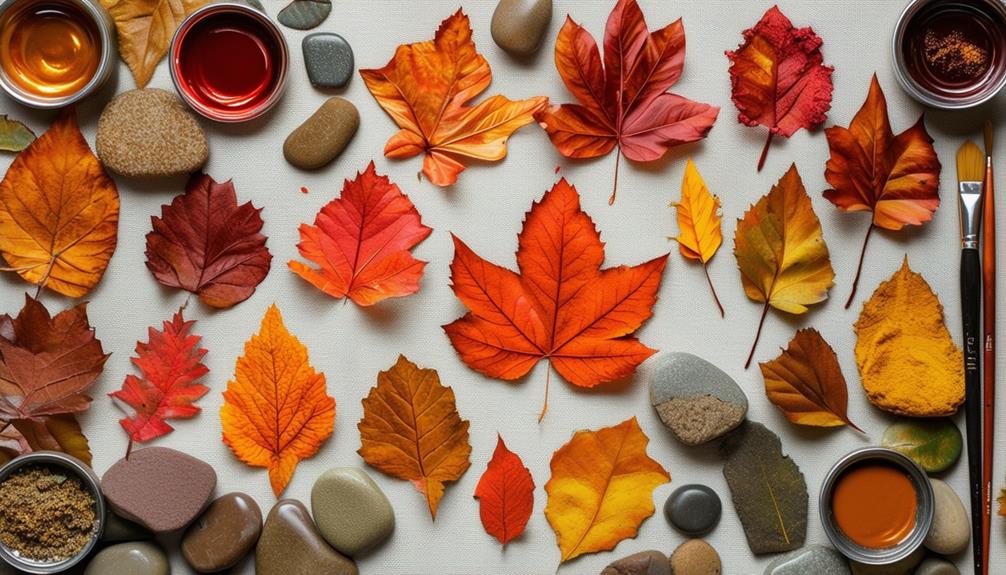
When exploring leaf painting techniques, you can create stunning patterns and textures using leaf stamping. Experimenting with color mixing can enhance the visual appeal of your artwork. Additionally, using different types of leaves will reveal how their unique shapes and veins contribute to your designs.
Leaf Stamping Methods
Leaf stamping is a creative method that utilizes the natural textures and shapes of leaves to create intricate patterns and designs. This technique enables the transfer of leaf veins and unique shapes onto various surfaces, offering an artistic exploration of the natural world.
To begin leaf stamping, gather the following materials: leaves, paint, and a stamping surface. Follow these steps to produce nature-inspired art:
- Select Your Leaves: Choose between fresh or dried leaves. Fresh leaves are more flexible, while dried leaves often yield more detailed impressions.
- Apply Paint: Use a brush or sponge to coat the leaf with a thin layer of paint, ensuring coverage of the entire surface, including the veins.
- Stamp: Press the painted side of the leaf onto your chosen surface, applying even pressure for a clear transfer. Carefully lift the leaf to reveal your design.
Experiment with various leaf types and colors to create diverse and captivating artworks.
Color Mixing Tips
Exploring color blending with natural materials like leaves can enhance your leaf painting techniques by offering a unique and vibrant palette. Start by experimenting with different types and shades of leaves. You'll discover a range of greens, yellows, and even reds through this simple method.
Use minimal water to maintain the consistency and vibrancy of your homemade colors. Crush and blend leaves with a few drops of water to create a paste-like paint, which allows for easier application and richer hues.
Layering and blending are crucial techniques. By layering different leaf-derived colors, you can create depth and texture in your artwork. Experiment with blending leaves with other natural materials like berries or grass to expand your palette and introduce unexpected tones.
Don't overlook rocks! Crushed rocks mixed with water can provide earthy tones and textures, adding another dimension to your leaf paintings. Use these color blending tips to explore and push the boundaries of your creativity. With natural materials, the possibilities are endless, making each creation distinctively your own.
Rock Painting Ideas
To begin your rock painting adventure, select stones that are smooth and durable, ensuring they have a solid surface suitable for painting. Once you've collected your materials, explore various creative ideas for your designs—whether they involve abstract patterns, realistic images, or scenes inspired by nature. Use different techniques to bring your artistic vision to life!
Selecting Perfect Rocks
Finding the ideal rocks for your painting projects starts with selecting smooth, level surfaces that are easy to embellish. Smooth, even stones make it simpler for paint to adhere and for you to craft detailed designs. Avoid stones with rough surfaces or sharp edges to ensure safety, especially if you're working with children. These young artists need materials that are easy to handle and safe to use.
Consider these tips when choosing your rocks:
- Size and Shape: Different painting designs work best on various rock sizes and shapes. Choose rocks that match your intended designs.
- Sturdy Structure: Select rocks that won't easily break during painting. This ensures durability and a more enjoyable painting experience.
- Clean and Dry: Always thoroughly clean and dry your rocks before painting. This step is crucial for the paint to stick properly.
Creative Design Techniques
After selecting the perfect rocks, it's time to unleash your creativity using various painting techniques to bring your designs to life. Rock painting offers a versatile canvas for artistic expression, allowing you to create anything from simple shapes and patterns to intricate landscapes and animals.
Begin by experimenting with dot painting. Utilizing different dot sizes, you can craft stunning mandalas or abstract designs. This method is ideal for beginners and provides endless possibilities. Another approach is line work, which involves using fine lines to create detailed images or geometric patterns. Line work can range from simple to complex, making it suitable for all skill levels.
Stenciling is another excellent technique to consider. By using stencils, you can achieve precise designs, whether it's a delicate floral pattern or a bold graphic. Stencils are especially helpful if you need to replicate a design multiple times.
Remember to seal your finished rock paintings with a clear coat. This step is crucial to preserve your designs and maintain vibrant colors over time. With these methods, you can transform ordinary rocks into extraordinary works of art.
Crafting With Flowers
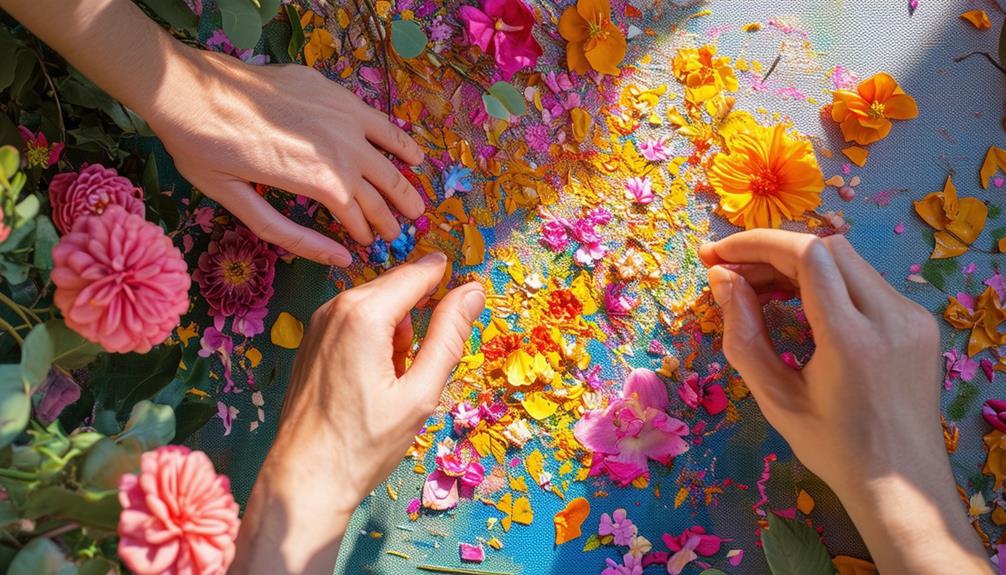
Crafting with flowers allows you to create vibrant and intricate designs that infuse a touch of nature into your art projects. By pressing or drying flowers, you can preserve their beauty and utilize them in various creative ways. Arranging flower petals in unique patterns and shapes enables you to craft captivating scenes.
Incorporating flowers into your artwork adds natural color and texture, making each piece truly unique. Whether you're creating a pressed flower collage or using dried petals to embellish a canvas, the possibilities are endless. Additionally, working with flowers fosters a deeper appreciation for nature's beauty.
Here are some engaging ways to use flowers in your art:
- Pressed Flower Art: Press flowers between heavy books to create flat, preserved pieces ideal for framing or card-making.
- Dried Flower Arrangements: Dry flowers to maintain their shape and use them in 3D art or decorative displays.
- Petal Pattern Designs: Arrange individual petals to form intricate designs, such as mandalas or landscapes, on paper or other surfaces.
Safety Tips for Nature Art
Ensuring safety while creating nature art is vital to prevent accidents and promote a fun, worry-free experience. Always use non-toxic art supplies, especially when working with children, to avoid exposure to harmful chemicals.
Supervise young children closely to prevent accidents when they're handling natural materials. Sharp objects like scissors can be hazardous, so monitor their use carefully. When collecting materials such as leaves and rocks, be cautious of potentially poisonous plants. It's essential to educate yourself and your children on what to avoid.
Proper hygiene is necessary—ensure everyone washes their hands after handling natural materials to prevent allergic reactions or irritations. Follow age-appropriate guidelines for activities and materials to guarantee safety and enjoyment for all age groups.
If you need further advice, consult experts or community groups. Trusted sources can provide detailed information and answer your questions. By following these tips, you can ensure a safe and enjoyable nature art experience.
Benefits of Nature Art

Once safety measures are in place, you can begin to appreciate the numerous benefits that nature art brings to both children and adults. One of the primary advantages is its positive impact on cognitive development and observation skills, particularly in young minds. When children engage in nature art, they learn to notice intricate details in leaves, rocks, and other natural materials, enhancing their ability to observe and analyze their surroundings.
Nature art activities also have significant mental health benefits. They improve mood, reduce stress levels, and encourage mindfulness. By immersing yourself in creating art with natural elements, you can find a sense of peace and relaxation that is difficult to achieve with other activities.
Additionally, nature art fosters a deeper environmental awareness and appreciation for the natural world. By working directly with materials from nature, you gain a better understanding and respect for the environment, which is essential for fostering sustainable habits.
Key benefits of nature art:
- Enhances creativity and cognitive development in children
- Improves mood and reduces stress for both children and adults
- Fosters environmental awareness and appreciation

